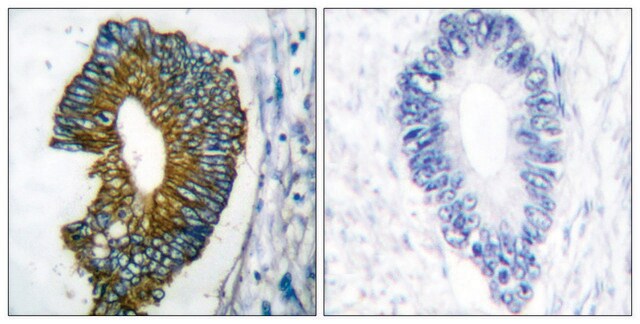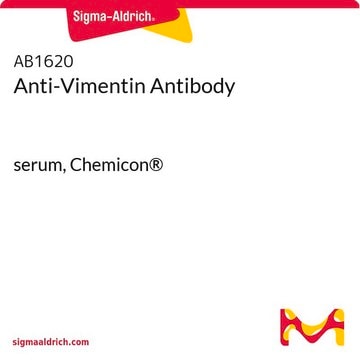ABT1383
Anti-phospho-Keratin-18 Antibody (Ser52)
from rabbit, purified by affinity chromatography
Synonym(e):
Keratin, type I cytoskeletal 18, Ser52-phosphorylated, Cell proliferation-inducing gene 46 protein, Ser52-phosphorylated, CK-18, Ser52-phosphorylated, Cytokeratin-18, Ser52-phosphorylated, K18, Ser52-phosphorylated, Keratin-18, Ser52-phosphorylated
About This Item
Empfohlene Produkte
Biologische Quelle
rabbit
Qualitätsniveau
Antikörperform
affinity isolated antibody
Antikörper-Produkttyp
primary antibodies
Klon
polyclonal
Aufgereinigt durch
affinity chromatography
Speziesreaktivität
human
Methode(n)
western blot: suitable
NCBI-Hinterlegungsnummer
UniProt-Hinterlegungsnummer
Versandbedingung
ambient
Posttranslationale Modifikation Target
phosphorylation (pSer52)
Angaben zum Gen
human ... KRT18(3875)
Allgemeine Beschreibung
Spezifität
Immunogen
Anwendung
Qualität
Western Blotting Analysis: A 1:5,000 dilution of this antibody detected upregulated Keratin-18 Ser52 phosphorylation in 10 µg lysate from phosphatase inhibitors Calyculin A- and Okadaic acid-treated HEK293 cells.
Zielbeschreibung
Sonstige Hinweise
Sie haben nicht das passende Produkt gefunden?
Probieren Sie unser Produkt-Auswahlhilfe. aus.
Lagerklassenschlüssel
12 - Non Combustible Liquids
WGK
WGK 1
Analysenzertifikate (COA)
Suchen Sie nach Analysenzertifikate (COA), indem Sie die Lot-/Chargennummer des Produkts eingeben. Lot- und Chargennummern sind auf dem Produktetikett hinter den Wörtern ‘Lot’ oder ‘Batch’ (Lot oder Charge) zu finden.
Besitzen Sie dieses Produkt bereits?
In der Dokumentenbibliothek finden Sie die Dokumentation zu den Produkten, die Sie kürzlich erworben haben.
Unser Team von Wissenschaftlern verfügt über Erfahrung in allen Forschungsbereichen einschließlich Life Science, Materialwissenschaften, chemischer Synthese, Chromatographie, Analytik und vielen mehr..
Setzen Sie sich mit dem technischen Dienst in Verbindung.







